Top News
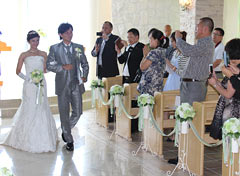
September 11, 2013 Ryukyu Shimpo
On September 10, on the invitation of the Okinawa Resort Wedding Association, a delegation from China attended a wedding demonstration held at a resort hotel in Onna. The number of couples in China who hold their wedding ceremony in resort hotels abroad is increasing and the association aims to attract such couples to Okinawa. The delegation chose the best location as that by a church overlooking the blue sea and a sandy beach.
Eighteen representatives from companies and groups involved in the Chinese wedding industry came from nine cities including Beijing, Shanghai, Hong Kong, and Chongqing and other locations further inland, as well as from Inner Mongolia. They took pictures of the ceremony hall from the inside and outside and of the models of the bride and groom.
The head of the Chinese government’s Wedding Industry Committee, which oversees the companies, said, “Locations facing the sea like this are just fantastic. I was really impressed and I would like to let Chinese people back home know about how wonderful it is.”
(English translation by T&CT, Mark Ealey)
Go to Japanese
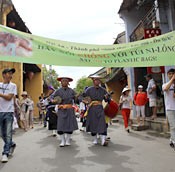
September 3, Ryukyu Shimpo
Nine members of the Naha Daiko, a drum group from Okinawa, performed their stirring dances at the “Hoi An – Japan Festival 2013” in Hoi An City in Vietnam on August 24 and 25.
After Naha City helped Hoi An to resolve waste-related issues, interaction between the cities and their people increased. Naha City sent the drum group to Hoi An as a part of this interaction.
Naha Daiko performed at the key opening and closing stages of the festival and enthralled the local audience. During their stay they walked through the streets as a michijune parade to call for waste reduction. It sometimes attracted such crowds of people as to cause traffic jams.
Naha Daiko members also visited the tomb of Japanese merchant Yajirobe Tani, a prominent trader in Vietnam during the Edo Period, and dedicated eisa dance to him.
(English translation by T&CT, Hitomi Shinzato and Mark Ealey)
Go to Japanese
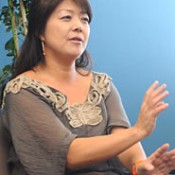
September 5, 2013 Ryukyu Shimpo
A documentary film titled The Target Village will be in theaters in Okinawa from September 7. The film covers residents of Takae Village, Higashi-son, who are opposed to the construction of U.S. military helipads and deployment of MV-22 Osprey there. Director Chie Mikami, a news anchor of Ryukyu Asahi Broadcasting (QAB), visited Ryukyu Shimpo Office in Ameku, Naha on September 4 to explain her thoughts on the work.
The television station made the film by extending an award-winning documentary made in Okinawa last year. It will be in theaters in 14 prefectures nationwide, screening in Naha from September 7 to October 11 at the Sakurazaka Theater. It will run from September 7 to 27 at Cinema Panic Miyakojima in Miyakojima City and on October 19 and 20 at Okinawa Civic Theater Ashibina in Okinawa City.
The film has already been screened from August in Tokyo and Osaka, playing to full audiences every day and receiving favorable comments. People in the audience who came to know the issue of Takae, which has received little attention from the Japanese major news media, gave their thoughts. One said, “I didn’t know that the role of media had stopped to the extent that it has.” Mikami said, “If people see the children of Takae in tears in the film, they will no longer say that they want to uphold Japan-U.S. Security Arrangements if that is the result.” She continued, “People will change their minds for sure when they come to know what is going on at Takae.”
The film describes the issue from the viewpoint of the residents. It also portrayed the difficult position of the people such as the Okinawa Defense Bureau personnel, the helipad construction workers and police who remove members of the protest movements. It showed there is no truly bad person there. Mikami said, “Through this film, I would like people to think about who it is who makes the children of Takae cry.”
Mikami, Okinawan media people and intellectuals held a mini-symposium at the Sakurazaka Theater after the morning premiere of the film on September 7.
For further details, call Sakurazaka Theater at 098 (860) 9555.
(English translation by T&CT, Lima Tokumori and Mark Ealey)
Go to Japanese
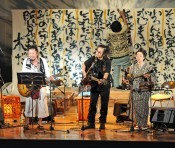
September 8, 2013 Ryukyu Shimpo
The Ryukyu Shimpo held an event in the evening of September 7 to commemorate the 110th anniversary of birth of the great Okinawan poet Baku Yamanokuchi. Held in Izumizaki, Naha and attended by about 450 people, it also celebrated the 120th anniversary of the establishment of the Ryukyu Shimpo. Those who attended spoke fondly of Yamanokuchi and his works.
In the first part of the event, the organizers invited Izumi Yamanokuchi, the poet’s oldest daughter, who now lives in Tokyo, to hold a round-table discussion. University of the Ryukyus Professor Sadatoshi Oshiro coordinated the talk. Two poets Yugo Nakazato and Yumi Nishihara, both winners of the Baku Yamanokuchi Award, and Tomoko Uda exchanged opinions.
In the second part, musicians performed and there was a stage play as a tribute to the works of Yamanokuchi.
Folksinger Kanako Horiuchi, musician Yutaka Sadoyama and rock band Maltese Rock took part in the event, taking the audience into the world of Yamanokuchi.
(English translation by T&CT, Mark Ealey)
Go to Japanese
September 7, 2013 Ryukyu Shimpo
Tetsuji Mitarai, associate professor at the Okinawa Institute of Science and Technology (OIST), and others, held a press conference at Okinawa Ocean Expo Park in Motobu in northern Okinawa on September 6. They said that researchers have set up equipment to constantly observe coral reef creatures and the environment in the sea off Bise in Motobu and have started fixed-point observation.
According to Mitarai, it is the first time a Japanese institution has set up equipment to observe the sea in real time. Few institutions in the world have managed this. The researchers expect to find new causes of coral bleaching.
On August 27, they set up the equipment at a depth of 20 meters at a spot one kilometer from the west side of Bisezaki. Three types of cameras and 15 types of sensors observe the sea and send data to OIST on the flow and speed of tidal currents, as well as oxygen and sea plankton levels.
According to Mitarai, the sea around Okinawa is the northern limit of coral reef ecosystems. Fixed-point observation gathers information valuable to researchers throughout the world.
Mitarai said, “If we can find what is happening with plankton levels, we can find out what causes coral bleaching.”
(English translation by T&CT, Mark Ealey)
Go to Japanese
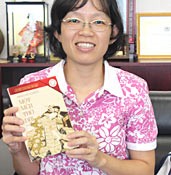
September 2, 2013 Ryukyu Shimpo
Nguyen Do An Nhien, a visiting fellow at Meio University Research Institute, has published Vietnamese translations of Japanese author Ichiyo Higuchi’s works Takekurabe and other two novels. Higuchi was Japan´s first prominent woman writer of modern times and Nhien is the first person to translate Higuchi’s short stories into Vietnamese from their original Japanese. She said, “Even if a different manner of expression is used, I can still empathize with the bonds of affection between parent and child in her works.”
Seeking to use literature to create a bridge between Okinawa and Vietnam, Nhien plans to introduce Okinawan folklore in Vietnam.
Higuchi’s works have been translated into Vietnamese from the foreign-language editions, but not direct from the original Japanese. When Nhien returned temporarily to her home country from Nago, a former teacher and a publisher encouraged her to translate and publish the works in Vietnamese. The project took over one year to complete. Nhien had previously studied Kenji Miyasawa’s works and translated them into Vietnamese during her master’s degree program at Meio University. She then turned her attention to Higuchi’s works. “They are representative works of Japanese literature. I have tried to study her works from a woman’s viewpoint,” she said.
She included the four works of “Jusanya (Thirteenth Night),” “Nigorie (Troubled Waters),” “Yamizakura” (Flowers at Dusk) and “Takekurabe” (Child’s Play) in one book. Nhien visited the places that appeared these works in order to best depict the four seasons of Japan, so she has experienced the world of Higuchi.
In addition to literary works, from this July Nhien has been introducing Okinawan folklore in a weekly magazine for Vietnamese children. “I like to introduce a variety of stories,” she said. With researchers at Osaka City University she translated “A Collection of Poems for Independence, Freedom and Requiem of Vietnam by 175 Poets,” which was published by Coalsack Co.
Seiki Senaha, the president of Meio University, encouraged her, saying, “Her desire to convey culture in interactive ways is marvelous. She is an inspiration to Japanese students. We want the students to follow her lead through international cultural exchange.”
(English translation by T&CT, Mark Ealey)
Go to Japanese
September 6, 2013 Yoko Takaesu of the Ryukyu Shimpo
The Okinawa Prefectural Government will set up a prefecture-wide council to plan a movement to restore good health and longevity among Okinawans. It will consist of representatives of 50 to 60 organizations such as economic and educational groups, healthcare institutions, and local municipalities. The government will also invite construction industry organizations with large numbers of employees to take part. The council will exchange opinions with each affiliated organization and create an action plan for improving Okinawan citizens’ health. The council will be central to facilitating the government’s health promotion plan called Health Okinawa 21.
Demographic research conducted across the country in 2010 revealed that Okinawa had the worst mortality rate of people under 65 years old. The numbers were 27.5% for men and 13.3% for women. Early death and decline of health among wage earners from youth to middle age have become key concerns. Taking the issue seriously, the government expects to expand the movement to include small-scale businesses by involving industries in the council.
Hirokazu Higa, a vice counselor of the government Health Promotion Division said, “We cannot change this with existing administrative procedures.” He continued, “Okinawa has many obese people and a high mortality rate among its working population.” Higa said, “We want to work with our citizens and change people’s awareness of the issue.”
According to the government, there has been a prefectural council in place to promote a plan called Health Okinawa 2010. This council consisted only of healthcare organizations such as the Prefectural Medical Association.
Hachiro Sakiyama of the Public Health Department said, “We hope various organizations will take part in the prefectural council and want to make health promotion a prefectural-wide movement.”
(English translation by T&CT, Megumi Chibana and Mark Ealey)
Go to Japanese
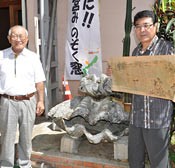
September 6, 2013 Ryukyu Shimpo
Eighty-four-year-old Hideo Nakamura used to conduct submersible surveys in various areas in Okinawa as an engineering official at the University of the Ryukyus. Nakamura contributed a 200 kilogram giant clam, barrel sponges and fishing gear to Nago Museum on August 31. He collected the clam in the sea off Kudaka Island and the barrel sponges in Oura Bay.
Nakamura, who fished in the Henoko area around 1947 after the Battle of Okinawa, said, “For me, Henoko and Oura Bay are “Life-giving gardens.” He went on to say, “The central government plans to reclaim the area, but I want Nago residents to understand the richness of the environment in the sea off the east coast of Okinawa.”
Barrel sponges are a barrel-shaped invertebrate organism. They take in nourishment by continually pumping water through the interior of the sponge. They are 45 centimeters wide and 35 centimeters high. The clam is 114 centimeters wide. It takes four adult men to lift it up. Nakamura found the clam and sponges during his submersible surveys in the 1980s.
He also gave sinkers for drive fishing and tide tables to the museum.
The fish disappeared in the sea around the Motobu area of Okinawa due to the naval bombardment by the U.S. military in the war. Around 1947, Nakamura and others carried a sabani boat down from the hills and fished in the Henoko and Higashi Village areas.
Nakamura said, “We traded fish for rice and the people of Henoko appreciated this as a valuable source of protein.” He went on to say, “The central government plans to reclaim the sea off Henoko to build a new U.S. military base, but I wanted to show gratitude to the sea that has helped us.”
Nakamura said, “The sea off Henoko and the east coast of Okinawa is rich in marine life. I want the people of Nago to understand this.” The museum displays the clam beside the front door so visitors can easily see it.
(English translation by T&CT, Mark Ealey)
Go to Japanese
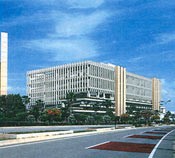
September 6, 2013 Fumitetsu Jahana of Ryukyu Shimpo
The Okinawa Prefectural Government plans to start building a new logistics center in the international industrial clusters area in Naha in January 2014. It should be complete by February 2015.
With five floors above ground and a total floor space of about 26,000 square meters, it will be about nine times bigger than the building that Yamato Holdings currently owns in the area. Yamato is a major logistics services provider offering courier services in Asia.
The government hopes to attract logistics companies to the area. They intend to create an international logistic center by taking advantage of the air cargo business of All Nippon Airways (ANA) that uses Naha Airport as the hub.

Construction will cost about 4.3 billion yen. A spiral road will be built to give containers and vehicles direct access to each floor and there will be rooftop parking for 100 vehicles. The government plans to begin business in the building in fiscal 2015. With three such buildings already in the area, the new center will be the fourth.
Yamato Transport, a subsidiary of Yamato Holdings, will move into the third building and will promote courier services in Asia using ANA hub projects.
The government has started a center for product parts in the area from August.
Toshiba Automation Systems Service, a subsidiary of the Toshiba Corporation, a multinational engineering and electronics conglomerate, moved into one of the buildings. The company is running trial operations with the center providing storage of product parts for the Asian and Western markets. More companies plan to move in the buildings.
Working with Yamato and ANA, the government hopes to attract centers for electronic product parts, repair centers and inventory control centers for e-commerce in Asia.
A government representative said, “So many companies want to move into the area that we cannot provide enough space. We want to continue to attract companies, further enhance our international logistics capacity and promote airport and coastal industries.”
(English translation by T&CT, Mark Ealey)
Go to Japanese
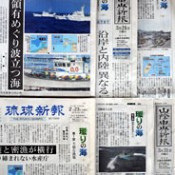
September 5, 2013 Ryukyu Shimpo
On September 4, the Japan Newspaper Publishers & Editors Association decided to award its 2013 editing and planning department prize to the Ryukyu Shimpo and Sanin Chuo Shimpo for their joint project “Meguri no Umi” (People around the Ocean rim).
Ryukyu Shimpo wins the prize for the fourth time in eight years, and the Shimane-based Sanin Chuo Shimpo for the first time. The Japan Newspaper Publishers & Editors Association’s prizes are awarded to works of the three departments of news, editing and planning, and photograph and film.
There were 74 applications for the award this year, including 46 to the editing and planning department. The Hokkaido Shimbun also wins the prize for the editing and planning department for its work titled “History of Japan and Russia on the ground.”
“Meguri no Umi” was published in both the newspapers from February 22 to June 23 this year. In response to tension between Japan and China, as well as Taiwan, over the Senkaku Islands, and between Japan and South Korea over Takeshima, the newspapers reported on the territorial issues from the point of view of people who live in the vicinity. Listening to the voices from local people in Okinawa and Shimane, and those from China, Taiwan and South Korea, they delivered a vision that does not provoke an armed conflict. They visited other foreign countries and regions involved in the territorial disputes to find the key to resolving the problems.

Click to enlarge (PDF file 4.2 MB)
The association was impressed with the article in which both newspapers had thoroughly taken on board the views of the fishermen and ordinary people living around the disputed sea borders in Japan and China, Taiwan and Korea. It pointed out that the territorial issue was easy to connect to nationalism, but they asked readers to be calm and to explore peaceful solutions.
The award ceremony will be held in the 66th National Newspaper Convention in Kagoshima City on October 16.
Thank you to our readers for their support
Yasutaka Hanashiro Executive Editor of the Ryukyu Shimpo:
We sometimes see territorial issues as the responsibility of the central government, which has the exclusive right to exercise sovereignty. Considering the relevant historical background, we would like to approach the problems with a regional perspective and with the views of ordinary citizens. The Japan Newspaper Publishers & Editors Association was impressed by our efforts to introduce the voices of people who live on opposite shores, and by the close cooperation achieved between regional newspapers. We thank the association for its recognition, and feel honored stimulated to continue our efforts. We would also like to thank our readers for their support and understanding.
We will further deepen cooperation in future
Toshinori Makino Executive Editor of the Sanin Chuo Shimpo:
Focusing on the common issues facing us all who live in the regions, we planned this series of articles to access public opinion with a regional perspective and the through eyes of residents. To send even stronger messages from locals than we have previously conveyed, we assumed a more aggressive approach in the joint project by our regional newspapers. This reminded us of the importance of newspaper coverage in the communities. We want to deepen cooperation between regional newspapers in the future.
(English translation by T&CT, Mark Ealey)
Go to Japanese
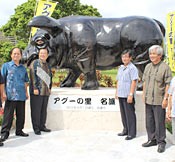
September 2, 2013 Ryukyu Shimpo
Nago City declared itself to be the “Home of Agu” on September 1. Through the years it has worked to save and promote the Okinawan native pig known as agu, which used to be threatened by extinction. A statue of an agu pig was unveiled in the ceremony held at the Civic Center to commemorate the declaration. People attending the ceremony, including meat producers and city officials, made comments such as “Agu is a symbol of Nago,” “It is our treasure,” and “We want to see it available throughout the world.”
According to Nago City, agu pigs were brought to Ryukyu from China during the 14th century, but their numbers decreased sharply after World War II. A survey carried out by Nago Museum throughout the prefecture from 1981 confirmed that only 30 of these pigs had survived. It looked after 18 of them and gave several to the Hokubu Agriculture and Forestry High School. The school worked to breed the animal back towards its original form, eventually reviving the agu variety in 1993.
At the ceremony, Mayor Susumu Inamine declared Nago to be the home of agu. He said, “Nago is where the original variety of Ryukyuan pig, the agu, has been revived.” The ceremony was held as a part of the City Animal Husbandry Festival. The organizers provided about 150 free meals to visitors, including roast pork and agu shabu-shabu.
Masatoshi Shimabukuro, the first director of the Nago Museum who worked to save and revive agu, said, “I am very happy that our efforts have been recognized. We want to strive to look after more agu and make use of them as we move forward.”
The statue of the agu represents a stocky male pig about three meters long between the tip of the nose and its backside and 1.7 meters high. It stands in front of the Civic Center facing out towards Route 58.
(English translation by T&CT, Mark Ealey)
Go to Japanese











 Webcam(Kokusai Street)
Webcam(Kokusai Street)


